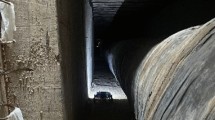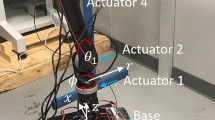Abstract
This study proposes a method of sensing basic pipeline elements, such as a straight pipeline, elbow, T-branch, and miter, by using a monocular camera and position sensitive device sensors. The method is composed of the three following parts: The pipeline elements are first determined; the T-branch and miter are then classified among them; and the opening directions of the T-branch and the elbow are recognized. We develop a sensor hardware and signal-processing algorithm for providing information on the pipeline elements required to navigate inside the pipelines. This algorithm is easily implementable without any heavy computational burden. The proposed method is tested in an in-pipe robot, called MRINSPECT VI. Subsequently, its effectiveness is validated.
























Similar content being viewed by others
Explore related subjects
Discover the latest articles, news and stories from top researchers in related subjects.References
Choi YS, Kim HM, Suh JS, Mun HM, Yang SU, Park CM, Choi HR (2014) Recognition of inside pipeline geometry by using monocular camera and PSD sensors. In: Proceedings of IEEE/ASME international conference on advanced intelligent, mechatronics, pp 634–639
Choi YS, Kim HM, Suh JS, Mun HM, Yang SU, Park CM, Choi HR (2014) Recognition of inside pipeline geometry by using PSD sensors for autonomous navigation. In: Proceedings of IEEE/RSJ international conference on intelligent robots and systems, pp 5024–5029
Hlavac V, Jeffery KG, Wiedermann J (2000) On vision-based orientation method of a robot head in a dark cylindrical pipe. In: Proceedings of conference on current trends in theory and practice of informatics, pp 365–374
Scholl KU, Kepplin V, Berns K, Dillmann R (2000) Controlling a multijoint robot for autonomous sewer inspection. In: Proceedings of international conference on robotics and automation, pp 1701–1706
Rome E, Surmann H, Streich H, Licht U, Paap K (2001) A custom IR scanner for landmark detection with the autonomous sewer robot MAKRO. In: Proceedings of international symposium on intelligent robotic systems, pp 457–466
Kolesnik M, Streich H (2002) Visual orientation and motion control of MAKRO-adaptation to the sewer environment. In: Proceedings of international conference on simulation of, adaptive behavior, pp 62–29
Birkenhofer C, Hoffmeister J, Dillmann R (2005) Compliant motion of a multi-segmented inspection robot. In Proceedings of international conference on intelligent robots and systems, pp 3353–3358
Ahrary A, Tian L, Kamata S, Ishikawa M (2005) An autonomous sewer robots navigation based on stereo camera information. In: Proceedings of IEEE international conference on tools with, artificial intelligence, pp 628–633
Nassiraei AAF, Kawamura Y, Ahrary A, Mikuriya Y, Ishii K (2007) Concept and design of a fully autonomous sewer pipe inspection mobile robot “KANTARO”. In: Proceedings of IEEE international conference on robotics and automation, pp 136–143
Ahrary A, Kawamura Y, Ishikawa M (2006) A laser scanner for landmark detection with the sewer inspection robot KANTARO. In: Proceedings of international conference on system of, systems engineering, pp 310–315
Ahrary A, Ishikawa M, Okada M (2007) Experimental evaluation of intelligent fault detection system for inspection of sewer pipes. In: Proceedings of international conference on intelligent robots and systems, pp 1248–1253
Lee JS, Roh SG, Kim DW, Moon H, Choi HR (2009) In-pipe robot navigation based on the landmark recognition system using shadow images. In: Proceedings of IEEE international conference on robotics and automation, pp 1857–1862
Lee DH, Moon H, Choi HR (2010) Landmark detection of in-pipe working robot using line-laser beam projection. In: Proceedings of international conference on control, automation and system, pp 611–615
Lee DH, Moon H, Choi HR (2011) Autonomous navigation of inpipe working robot in unknown pipeline environment. In: Proceedings of IEEE international conference on robotics and automation, pp 1559–1564
Roh SG, Kim DW, Lee JS, Moon H, Choi HR (2008) Modularized in-pipe robot capable of selective navigation inside of pipelines. In: Proceedings of IEEE/RSJ international conference on intelligent robots, systems, pp 1724–1729
Kim DW, Roh SG, Lee JS, Lee SH, Choi HR (2008) Development of in-pipe robot using clutch-based selective driving algorithm. Trans Korea Soc Mech Eng 32(3):223–231
Roh SG, Ryew SM, Choi HR (2001) Development of differentially driven inpipe inspection robot for underground gas pipeline. Trans Korea Soc Mech Eng 25(2):2019–2029
Roh SG, Choi HR (2005) Differential-drive in-pipe robot for moving inside urban gas pipelines. IEEE Trans Robot 21(1):1–17
Kim HM, Suh JS, Choi YS, Tran DT, Moon H, Koo JC, Ryew SM, Choi HR (2013) An in-pipe robot with multi-axial differential gear mechanism. In: Proceedings of IEEE/RSJ international conference on intelligent robots systems, pp 252–257
Schempf H, Mutschler E, Gavaert A, Skoptsov G, Crowley W (2010) Visual and nondestructive evaluation inspection of live gas mains using the Explorer\(^{TM}\) family of pipe robots. J Field Robot 27(3):217–249
Jung EJ, Yi BJ (2013) Task-oriented navigation algorithms for an outdoor environment with colored borders and obstacles. Intell Serv Robot 6(2):66–77
Morioka K, Yamanaka S, Hoshino F (2014) Simplified map representation and map learning system for autonomous navigation of mobile robots. Intell Serv Robot 7(1):25–35
Gai S, Oh SM, Yi BJ (2015) ASC localization in noisy environment based on wireless sensor network. Intell Serv Robot 8(4):201–213
Al-Muteb K, Faisal M, Emaduddin M, Arafah M, Alsulaiman M, Mekhtiche M, Hedjar R, Mathkoor H, Algabri M, Bencherif MA (2016) An autonomous stereovision-based navigation system (ASNS) for mobile robots. Intell Serv Robot 9(3):187–205
Hu MK (1962) Visual pattern recognition by moment invariants. IRE Trans Inf Theory IT–8:179–187
Flusser J (2000) On the independence of rotation moment invariants. Pattern Recognit 33:1405–1410
Flusser J, Suk T (2006) Rotation moment invariants for recognition of symmetric objects. IEEE Trans Image Process 15:3784–3790
Acknowledgements
This work is a part of a research project supported by the Ministry of Knowledge Economy (MKE) through the “Development of self-powered robots for nondestructive inspection of 8” and 16” unpiggable pipelines.” Also, this research was partially supported by Basic Science Research Program through the National Research Foundation of Korea(NRF) funded by the Ministry of Education(No. 2016R1A6A3A11932345). The authors wish to express their gratitude for the financial support.
Author information
Authors and Affiliations
Corresponding author
Rights and permissions
About this article
Cite this article
Choi, Y.S., Kim, H.M., Mun, H.M. et al. Recognition of pipeline geometry by using monocular camera and PSD sensors. Intel Serv Robotics 10, 213–227 (2017). https://doi.org/10.1007/s11370-017-0221-1
Received:
Accepted:
Published:
Issue Date:
DOI: https://doi.org/10.1007/s11370-017-0221-1




